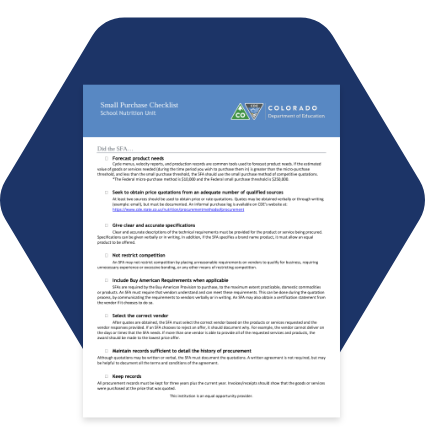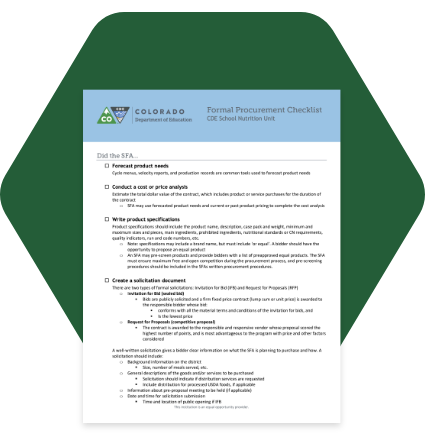CDE will be closed on Monday, September 1, for the Labor Day holiday.
You are here
Source Food, Supplies and Services
Sourcing food, supplies and services is also known as procurement: the multi-step process used to obtain goods or services. Review the resources below to source food, supplies or services for your program.
Jump To:
Methods of Procurement
The appropriate procurement method to use depends on the dollar amount of the expected purchase. Sponsors should evaluate what goods or services are needed and for how long, and determine which procurement method to use based on the estimated dollar value of the purchase. All procurement must be conducted in a manner that maximizes free and open competition.
Process for procurement:
- Evaluate menus to determine what food products will be needed throughout the school year, and an estimate of how much of each product will be ordered.
- Using that information, estimate the total cost of food products for the school year and make a decision on what procurement method to use to purchase them.
- For frequent purchases made to the same vendor (example: your prime vendor for food), estimate the total dollar value of the whole school year, not each individual purchase. This is because the contract length is typically the school year, not week to week.
- Other purchases that are a one-time purchase or a specific duration (example, three months) may be evaluated differently.
Micro-Purchases (<$10,000 spent annually)
A micro-purchase is defined as a purchase where the aggregate dollar value does not exceed $10,000. To meet the requirement for competition, purchases should be distributed equally among qualified suppliers with reasonable prices (to the extent practicable). Purchase prices of goods must be reasonable based on research, experience, purchase history, or other information; and this documentation should be kept on file.
Sponsors can self-certify a micro-purchase threshold of up to $50,000. If your district or organization chooses to update your micro-purchase threshold, make sure your procurement policies are also updated to maintain compliance.
This self-certification must be completed annually, and include:
- A justification
- Clear indication of the new threshold
- Supporting documentation of any of the following:
- A qualification as a low-risk auditee, in accordance with the criteria in 2 CFR 200.520
- An annual internal institutional risk assessment to identify, mitigate, and manage financial risks
Small/Informal Purchases ($10,000 - $250,000 OR the most restrictive threshold)
The federal small purchase threshold is $250,000. However, your district/LEA/organization may have a more restrictive threshold. If so, the most restrictive threshold must be followed. However, there may NOT be a different small purchase threshold for federal vs. non-federal purchases, and the sponsor must follow one consistent procurement policy.
For purchases that do not exceed the small purchase threshold, price or rate quotations may be used.
- Quotes may be verbal or written, but must be documented
- Public notice is not required
- Award the contract (purchase) to the lowest price from a responsible bidder who submits a responsive bid
- Documented quotes and receipts

If your district or organization updates its micro-purchase threshold, the lowest value of the small purchase threshold should be replaced with the amount your district has self-certified for micro-purchases.
Formal Procurement (>$250,000 OR most restrictive threshold)
A cost or price analysis must always be conducted prior to soliciting goods or services where the value exceeds the small purchase threshold.
Formal solicitations must include certain language, including:
- Requirements regarding the Buy American Provision
- 2 CFR 200 Appendix II clauses, as applicable.
Procurement Resources:

Procurement by Noncompetitive Proposals
Noncompetitive procurement may only be used when one or more of the following circumstances apply:
- The item is available only from a single source
- The public exigency or emergency for the requirement will not permit a delay resulting from competitive solicitation
- The CDE Office of School Nutrition expressly authorizes noncompetitive proposals in response to a written request from the SFA
- After solicitation of a number of sources, the competition is determined inadequate
Policy & Standards of Conduct
Procurement Policy
The sponsor must maintain written policies and procedures that reflect applicable federal, state, and local regulations.
These policies should include:
- The procurement methods to be used
- A requirement that costs incurred must be necessary and cost-effective
- A requirement that procurement avoids the acquisition of unnecessary or duplicative items
- All procurement transactions must provide full and open competition
- A requirement that the sponsor must maintain records sufficient to detail the history of procurement
- Procedures for evaluation of proposals, including procedures for the use of the market basket cost analysis method if applicable
- A requirement to conduct a cost or price analysis for all formal bids and/or contract modifications
- Steps that the sponsor will take to assure that small, minority, and women's business enterprises and labor surplus firms are used when possible.
Download the Procurement Plan Template
Standards of Conduct
The sponsor must maintain written standards of conduct covering conflicts of interest and governing the actions of its employees engaged in the selection, award, and administration of contracts. The written standards of conduct may be included in the written procurement policy or may be maintained in a separate policy.
These standards must:
- Prohibit soliciting or accepting gratuities, favors, or anything of monetary value from contractors or parties of subcontracts
- Include disciplinary actions for violations of the policy
Capital Equipment Purchases & Approval Procedures
Capital Equipment is defined by federal regulations as tangible personal property (including information technology systems), having a useful life of more than one year, and a per-unit acquisition cost which equals or exceeds the lesser of the capitalization level established by the SFA/LEA for financial statement purposes, or $10,000.00. Click here for more information on Equipment Grants.
These procedures become relevant for School Food Authorities that plan to purchase Capital Equipment using Food Service (Fund 21) funds.
Capital Equipment Approval Procedures:

Complete the Equipment Purchase Approval Tree to determine if the equipment purchase is allowable and if the equipment is on the Prior Approved List.

If the equipment is allowable and on the prior approved list, keep the Approval Tree for your records. The SFA may purchase the equipment and does not need further approval.

If the equipment is allowable but it is not on the Prior Approved List, Complete the Capital Equipment Approval Form for CDE approval.
Buy American Provision
The William F. Goodling Child Nutrition Reauthorization Act of 1998 requires school food authorities to purchase, to the maximum extent practicable, domestic commodity or product.
Domestic commodity or product is defined as an agricultural commodity that is produced in the United States and a food product that is processed in the United States using substantial agricultural commodities that are produced in the United States.
Exceptions
Limited exceptions to the Buy American Provision allow for the purchase of products not meeting the “domestic” standard.
Before using an exception, alternatives must be considered:
- Are there other domestic sources for this product?
- Is there a domestic product that could be easily substituted, if the non-domestic product is less expensive?
- Am I soliciting bids for this product at the best time of year? If I contracted earlier or later in the season, would prices and/or availability change?
Exceptions to the Buy American Provision should be used as a last resort; however, an alternative or exception may be approved upon request.
Exceptions include:
- The product is listed on the Federal Acquisitions Regulations Nonavailable list found at 48 CFR 25.104 and/or is not produced or manufactured in the US in sufficient and reasonably available quantities of satisfactory quality; or
- Competitive bids reveal the costs of a U.S. product are significantly higher than the non-domestic product.
Requests should include:
- Alternative substitute (s) that are domestic and meet the required specifications:
- Price of the domestic food alternative substitute (s); and
- Availability of the domestic alternative substitute (s) in relation to the quantity ordered.
- Reason for exception: limited/lack of availability or price (include price):
- Price of the domestic food product; and
- Price of the non-domestic product that meets the required specification of the domestic product.
Review the resources below for additional information on Buy American Provision exceptions.
Caps on Nondomestic products:
Beginning in School Year 2025-26 School Food Authorities should not exceed the following caps outlined in in 7 CFR 210.21(d)(5) and 7 CFR 220.16(d)(5).
- Percent of total commercial food costs that may be non-domestic:
- Starting in SY 2025-26: 10% of total food costs
- Starting in SY 2028-29: 8% of total food costs
- Starting in SY 2031-23: 5% of total food costs
Accommodation Process:
If you cannot meet the 10% cap for SY 2025-26, you may complete the Buy American Accommodation Request form.
Procurement Resources



Connect With Us





